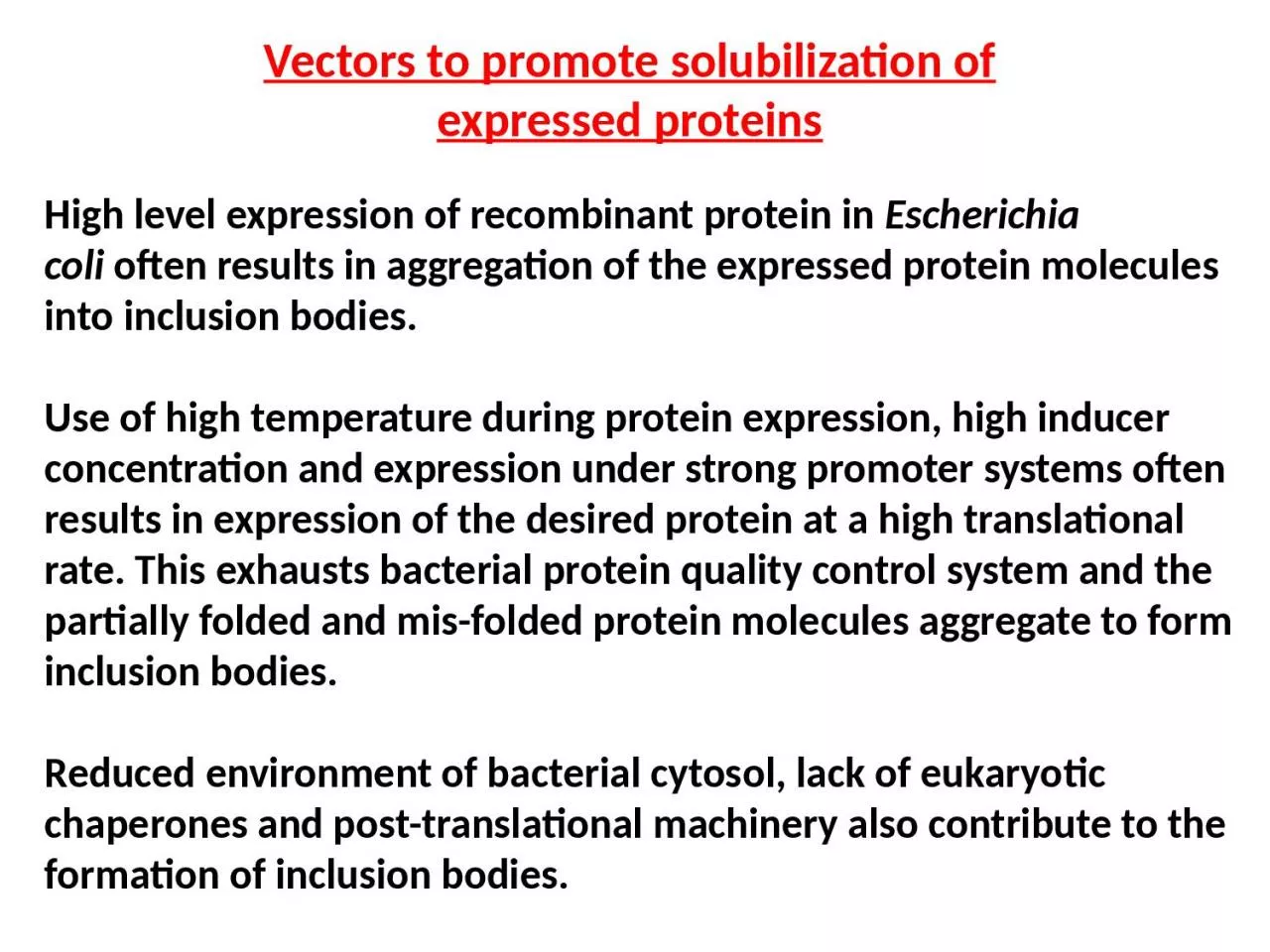

Escherichia coli often results in aggregation of the expressed protein molecules into inclusion bodies Use of high temperature during protein expression high inducer concentration and expression under strong promoter systems often results in expression of the desired protein at a high tra ID: 1040394
Download Presentation The PPT/PDF document "High level expression of recombinant pro..." is the property of its rightful owner. Permission is granted to download and print the materials on this web site for personal, non-commercial use only, and to display it on your personal computer provided you do not modify the materials and that you retain all copyright notices contained in the materials. By downloading content from our website, you accept the terms of this agreement.
1. High level expression of recombinant protein in Escherichia coli often results in aggregation of the expressed protein molecules into inclusion bodies. Use of high temperature during protein expression, high inducer concentration and expression under strong promoter systems often results in expression of the desired protein at a high translational rate. This exhausts bacterial protein quality control system and the partially folded and mis-folded protein molecules aggregate to form inclusion bodies. Reduced environment of bacterial cytosol, lack of eukaryotic chaperones and post-translational machinery also contribute to the formation of inclusion bodies.Vectors to promote solubilization ofexpressed proteins
2.
3.
4. Formation of inclusion bodies imposes a great hurdle in production and purification of recombinant proteins using E. coli as host. Inclusion bodies need extensive processing involving isolation from cell, solubilization, refolding and purification to produce the bioactive proteins.
5. Two parameters that can be manipulated to reduceinclusion-body formation are temperature andgrowth rate. There are a number of reports whichshow that lowering the temperature of growthincreases the yield of correctly folded, soluble protein. Media compositions and pH valuesthat reduce the growth rate also reduce inclusion bodyformation. Renaturation of misfolded proteinscan sometimes be achieved following solubilizationin guanidinium hydrochloride
6. Recovery of bioactive proteins from inclusion bodiesAs protein molecules are in an aggregated state in inclusion bodies, it is a challenging task to solubilize inclusion bodies and refold the solubilized proteins into bioactive form. The conventional strategy to purify proteins from inclusion bodies consists of four major steps: isolation of purified inclusion bodies, solubilization of inclusion bodies, refolding of solubilized proteins and purification of refolded proteins by various chromatographic techniques. Solubilization of inclusion bodies and refolding of solubilized protein molecules into native conformation are the most crucial steps in the recovery of bioactive protein from inclusion bodies.
7.
8.
9. Traditionally, inclusion bodies are solubilized using high concentration of denaturants and chaotropes like urea and guanidine hydrochloride (GdnHCl). For proteins containing multiple cysteine residues, β-mercaptoethanol or dithiothreitol are added in these solubilization agents to reduce incorrect disulfide bonds. Solubilization of inclusion bodies using high concentration of chaotropes results in complete disruption of protein structure. This, in some cases, leads to aggregation of protein molecules during refolding process. As inclusion body aggregates have been shown to have native-like secondary structures and can have activity, it is advantageous to use a “mild” solubilization process which does not completely unfold these native-like protein structures
10. Three ‘genetic’ methods of preventing inclusion body formation have been described.In the first of these, the host cell is engineered to overproduce achaperon (e.g. DnaK, GroEL or GroES proteins) in addition to the protein of interest Castanie et al. (1997) have developed a series of vectors which are compatible with pBR322-type plasmids and which encode the overproduction of chaperons. These vectors can be used to test theeffect of chaperons on the solubilization of heterologousgene products. Even with excess chaperon there is no guarantee of proper folding. The second method involves making minor changes to theamino acid sequence of the target protein. For example, cysteine-to-serine changes in fibroblast growth factor minimized inclusion-body formation (Rinas et al. 1992).
11. The third method is derived from the observation that many proteins produced as insoluble aggregates in their native state are synthesized in soluble form as thioredoxin fusion proteins. Davis et al. (1999) have shown that the NusA and GrpE proteins, as well as bacterioferritin, are even better than thioredoxin at solubilizing proteins expressed at a high level. Kapust and Waugh (1999) have reported that the maltose-binding protein is also much better than thioredoxin.